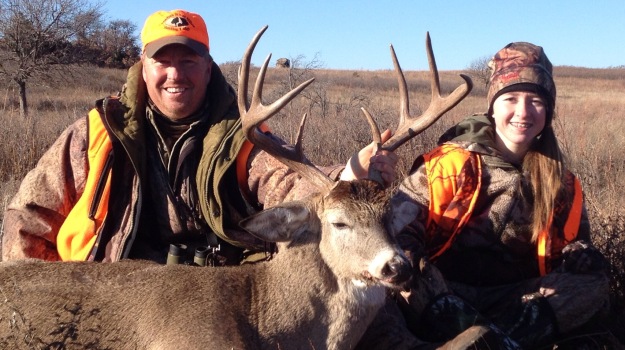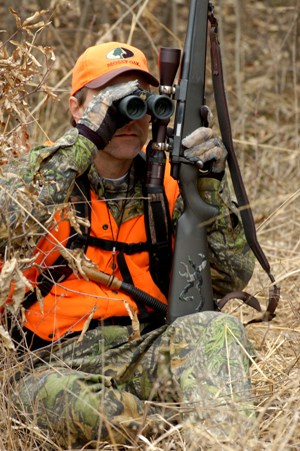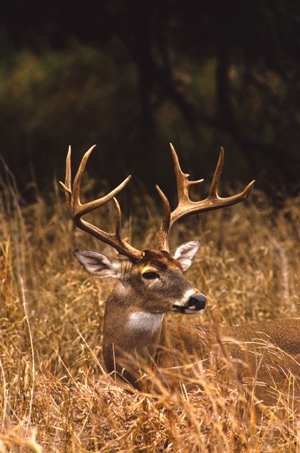with Justin Eakins

Editor’s Note: Justin Eakins owns Canadian River Hilton Hunting Lodge in Crawford, Oklahoma, on the Canadian River. Justin hunts on 25,000 to 30,000 acres of land and has been one of the co-hosts on Mossy Oak’s “Deer T.H.U.G.S.” TV show for 6 years.
Mossy Oak: Justin, how long are your hunts?
Justin: We offer 5-day hunts, and during each 5-day hunt, a hunter can take a buck, a doe and a hog if they see one. When we’re talking about wildlife management, in many areas of the country, managing the hogs on your land has a direct effect on how many deer on the land you can hunt. The hogs compete with the deer for food, and deer just don’t like to be around hogs. That’s why we ask our hunters to shoot any hog they see. I often use dogs to hunt hogs. We’ve learned that hunting pressure and chasing hogs with dogs helps keep the hogs off our property, so they don’t have a negative impact on our land. We’ve learned that the more hunting pressure we put on the hogs with dogs and hunters, the more-reluctant the hogs are to return. I won’t say that we eliminate the hogs, but I do know that hunting pressure can be an effective tool to keep the hogs off your land as much as possible. However, generally you can’t hardly put enough hunting pressure on these 4-legged vacuum cleaners just by hunting and shooting them.
Mossy Oak: Do you hunt from tree stands, ground blinds or elevated platforms?
 Eakins: One of the decisions that I made on the property we hunt is once I find a mature buck, I will hunt any way I need to hunt that’s safe and legal and will give our hunters the best chances to take mature bucks. We use tree stands and/or ground blinds, but I believe that the tree stand gives us the best advantage for taking our whitetails. The way we scout, we call it scouting at a distance. Although I know where the travel trails and bedding areas of the bucks are located, I know that the more times I go into that buck’s region, then the more I’m introducing human odor there, the harder it will be for my hunters to take a buck where I’m trying to scout. So, we use trail cameras extensively.
Eakins: One of the decisions that I made on the property we hunt is once I find a mature buck, I will hunt any way I need to hunt that’s safe and legal and will give our hunters the best chances to take mature bucks. We use tree stands and/or ground blinds, but I believe that the tree stand gives us the best advantage for taking our whitetails. The way we scout, we call it scouting at a distance. Although I know where the travel trails and bedding areas of the bucks are located, I know that the more times I go into that buck’s region, then the more I’m introducing human odor there, the harder it will be for my hunters to take a buck where I’m trying to scout. So, we use trail cameras extensively.
To stay out of the area that I’m scouting when I think the buck is coming through there, I’ll often put out trail cameras and check them once a week. From the trail cameras, I will know what size the bucks are, when they’re coming through the area where the camera is placed, and which direction the buck is going. This information helps me plan my hunts. Putting trail cameras in certain areas at specific times of the day allows me to tell my hunter which direction a buck will travel coming into and going out of a region. I also know from my trail-camera surveys which areas will be the best to hunt from in the mornings and in the afternoons. Trail cameras drastically have changed the way most deer hunters hunt, and which bucks each hunter wants to take. We constantly move our trail cameras throughout the year. Putting out cameras and checking cameras takes up much of our time. Once we find an older-age-class buck in a particular place, we’ll often put several more cameras in that spot to better pattern that buck and find out where he’s moving. The trail cameras also tell us which direction our tree stands need to face and where to place tree stands for different wind directions
To contact Justin Eakins, call him at 580-497-7500 or email him at hunt@dobsonteleco.com.
Justin Eakins on How to Manage Deer to Take Older Age Class Bucks






























